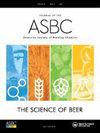Exploring Fungal Species Diversity in the Premature Yeast Flocculation (PYF) of Barley Malt Using Deep Sequencing
IF 1.8
4区 农林科学
Q4 BIOTECHNOLOGY & APPLIED MICROBIOLOGY
Journal of the American Society of Brewing Chemists
Pub Date : 2022-03-02
DOI:10.1080/03610470.2021.2025329
引用次数: 1
Abstract
Abstract Premature yeast flocculation (PYF) is the early flocculation of yeast during fermentation, which causes logistical and financial hardship to the malting and brewing industries. The occurring of PYF is suspected to be caused by the fungal infection of the barley or at least in part. The aim of this study was to perform a non-culture approach to uncover the fungal diversity in PYF malt. The genomic DNA was extracted and analyzed by amplicon sequencing. A total pairs read number of 209,523 sequences was obtained and used for taxonomic classification. The dominant fungal communities on the PYF malt were obtained based on the microbial diversity analysis by species annotation. The internal transcribed spacers sequencing analysis showed a decreased number of fungal species in PYF malt. Results showed that compared with control malt, PYF malt displayed a higher abundance of Ascomycota at the phyla level, and the abundance of Candida and Gibberella was exceptionally high in two PYF malts at the genus level. The absolute abundance of Candida and Gibberella baccata at the species level was also higher in PYF malts. The fungal species diversity within the malt indicated that the fungi community diversity was greater in the control malt than in the PYF malt. Taken together, exploring the diversity of the fungal community could be useful for malt quality control and for eliminating contamination risks.利用深度测序技术研究大麦麦芽早酵母絮凝(PYF)过程中真菌物种多样性
摘要酵母早絮凝(PYF)是酵母在发酵过程中的早期絮凝现象,给麦芽和酿酒行业带来了物流和经济上的困难。PYF的发生被怀疑是由大麦的真菌感染引起的,或者至少部分是这样。本研究的目的是执行非培养方法,以揭示真菌多样性的PYF麦芽。提取基因组DNA并进行扩增子测序分析。共获得209,523对序列,并用于分类分类。通过物种注释的微生物多样性分析,获得了PYF麦芽的优势真菌群落。内部转录间隔序列分析显示,PYF麦芽中真菌种类数量减少。结果表明,与对照麦芽相比,PYF麦芽在门水平上显示出更高的子囊菌群丰度,在属水平上,两种PYF麦芽的念珠菌和赤霉素丰度异常高。在种水平上念珠菌和巴卡赤霉素的绝对丰度在PYF麦芽中也较高。麦芽内真菌种类多样性表明,对照麦芽真菌群落多样性大于PYF麦芽。总之,探索真菌群落的多样性可能有助于麦芽质量控制和消除污染风险。
本文章由计算机程序翻译,如有差异,请以英文原文为准。
求助全文
约1分钟内获得全文
求助全文
来源期刊

Journal of the American Society of Brewing Chemists
工程技术-生物工程与应用微生物
CiteScore
4.00
自引率
20.00%
发文量
41
审稿时长
3 months
期刊介绍:
The Journal of the American Society of Brewing Chemists publishes scientific papers, review articles, and technical reports pertaining to the chemistry, microbiology, and technology of brewing and distilling, as well as the analytical techniques used in the malting, brewing, and distilling industries.
 求助内容:
求助内容: 应助结果提醒方式:
应助结果提醒方式:


